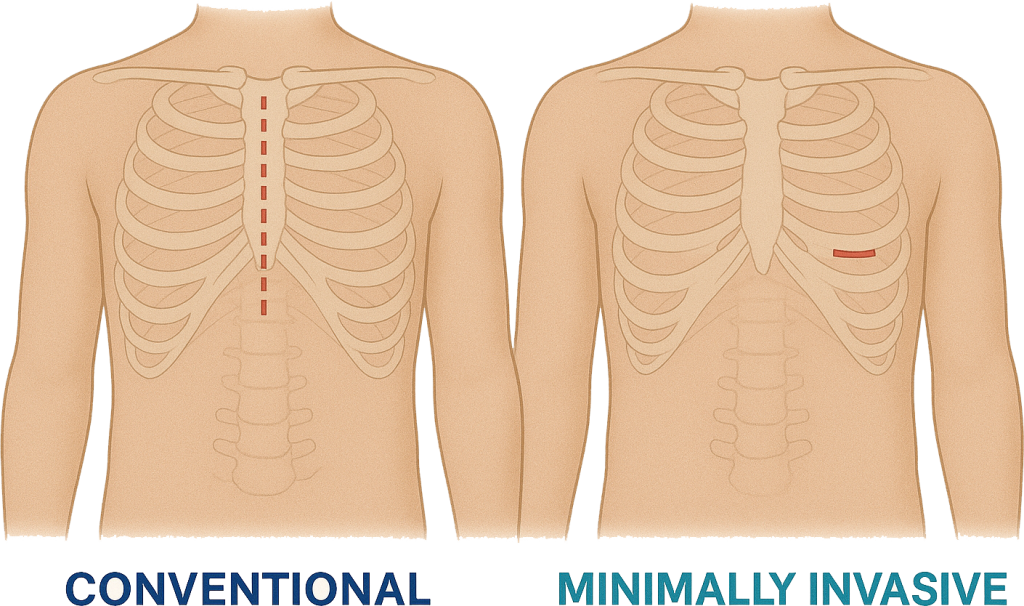A New Era in Minimally Invasive Cardiac Surgery:
The TCRAT Technique and Our Innovative Solutions
In cardiac surgery, the ultimate goal has always been to provide the safest and least traumatic treatment for patients. In line with this goal, the TCRAT (Total Coronary Revascularization via Left Anterior Thoracotomy) technique, developed by Dr. Oleksandr Babliak, has emerged in recent years as one of the most innovative approaches in coronary surgery. As this technique continues to evolve, it is currently performed by a limited number of highly specialized surgeons.
Overview of the TCRAT Technique
TCRAT enables multivessel coronary artery bypass surgery to be performed through a small incision on the left side of the chest, instead of a traditional sternotomy (sternal incision).
Before the introduction of this method, Coronary Artery Bypass Grafting (CABG) was the standard approach. CABG involves a midline vertical incision through the sternum to access the heart, providing a wide field of view for the surgeon. However, sternotomy is associated with greater postoperative pain, longer recovery times, and more prominent scarring.
Other known techniques in coronary surgery include MIDCAB (Minimally Invasive Direct Coronary Artery Bypass), while MVR (Mitral Valve Replacement/Repair), AVR (Aortic Valve Replacement), and congenital defect repairs such as ASD (Atrial Septal Defect) and VSD (Ventricular Septal Defect) are also performed using minimally invasive approaches. However, TCRAT stands out as a modern method providing total revascularization, particularly for patients with multivessel coronary artery disease.
Advantages of the TCRAT Technique
- The heart is accessed through a small left anterior thoracotomy incision, without cutting the sternum. This spares patients from the pain and prolonged healing process associated with sternotomy, allowing a faster return to daily activities and reducing the need for pain medication.
- The incision site and size offer a cosmetic advantage, especially for young and female patients, as the scar is less visible.
- Reduced tissue trauma minimizes intraoperative bleeding and postoperative blood loss, significantly decreasing the need for transfusions.
- The risk of infection is notably lower compared to conventional sternotomy (CABG).
- The approach provides enhanced surgical access, especially for working on the Left Internal Mammary Artery (LIMA) and Left Anterior Descending (LAD) artery, allowing greater precision and control.
- Using the Babliak retractor, clamps, and blades designed specifically for this approach, the surgeon operates in a less traumatic field with improved safety and stability.

This technique avoids bone cutting and accesses the heart through intercostal spaces, utilizing advanced technology and surgical expertise.As a result, patients experience faster recovery and less pain, enabling them to return to their normal lives much sooner compared to traditional CABG procedures.
The technique is gradually being adopted by more surgeons worldwide, with educational programs supporting its dissemination. Studies published by Dr. Babliak and his team have demonstrated that TCRAT provides reliable and favorable mid-term outcomes. Today, many centers are beginning to include this method among their standard surgical approaches.
Our Contribution: The Patented IDOL Babliak Minimally Invasive Retractor Set
In advanced techniques like TCRAT, it is essential that the surgeon maintains a clear and stable view of the operating field. To support this, we have designed and produced the patented IDOL Babliak (TCRAT) Minimally Invasive Set, optimized for ergonomics and functionality.
The IDOL TCRAT MICS Retractor Systems are used in mini-thoracotomy approaches to separate the ribs through intercostal spaces. By changing the blades within the set, the system can also be used as a rib-lifting device during Internal Mammary Artery (IMA) harvesting, widening the intercostal space to allow safe dissection of the IMA.
Advantages
- Provides a wide and stable surgical view through a small incision.
- Minimizes tissue trauma by applying low-pressure retraction.
- Its ergonomic structure allows the surgeon to operate more comfortably and efficiently.
- Maintains stability throughout the procedure, improving time efficiency.
- Features a modular design adaptable to different patient anatomies.

Babliak Aortic Clamp: Precision and Safety Combined
Another essential component of TCRAT procedures is the Babliak Clamp. This specialized aortic clamp is designed to allow safe clamping of the aorta through a small incision in the left second intercostal space.
Due to the structural characteristics of the aorta, standard clamps often fail to provide sufficient stability and secure closure during aortic clamping. The Babliak Clamp overcomes this anatomical challenge with its unique design. As the clamp’s locking mechanism engages, the distal ends align and begin to close, forming an oval contour that conforms perfectly to the aortic wall.
Key Benefits
- Ensures secure and stable clamping of the aorta without slippage.
- Provides reliable blood flow occlusion.
- Ergonomic design reduces hand fatigue during long operations, enhancing surgeon comfort.
- The atraumatic teeth on the jaws minimize the risk of aortic wall injury.
Future Perspective
Minimally invasive cardiac surgery aims to improve both patient comfort and surgical outcomes simultaneously. In line with this vision, our patented retractor system and aortic clamp are designed to facilitate the safe application of advanced techniques such as TCRAT.
With solutions that meet the needs of surgeons and enhance the quality of life for patients, we are shaping the future of minimally invasive cardiac surgery together.
